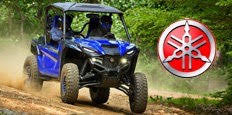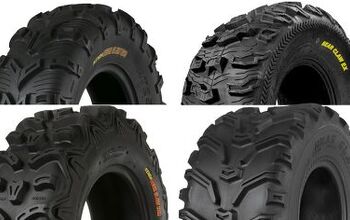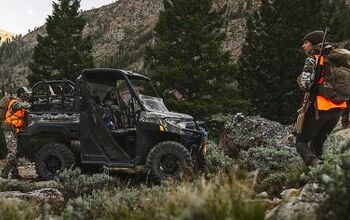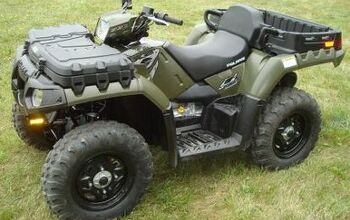How To Get Your ATV To Fit You Better
While they often get lumped together, ATVs and UTVs are vastly different off-road machines. Where UTVs respond to controls similarly to a car or truck, ATVs allow you to use your body to better control how they move. To take full advantage of this relationship between rider and machine, there are a number of simple adjustments you can make to get your ATV to fit you perfectly. And when an ATV fits you properly, you can get a whole lot more out of it.
Looking to provide you with the best information possible on improving your fit on your ATV, we chatted with Yamaha ATV / SxS Testing Manager Pat Biolsi to get some tips on how to take full advantage of an ATV’s adjustability to improve its handling.
The first place to start when you are looking to get the best fit out of your ATV is handlebar position.
“General rule or good starting point is to have the handlebar angle match the same angle as the steering stem when viewed from the side of the vehicle,” says Biolsi. “You can rotate them forward or back a few degrees, which can equal a few inches at the grips and make a significant change to the feel of the ATV.”
Biolsi points out that the handlebar on the [Yamaha] YFZ450R has two sets of mounting holes and eccentric handlebar mounts, so you have four different handlebar positions – each offering a change of 10mm.
“From your Yamaha dealer, the YFZ450R is delivered with the handlebar mounts in the rear hole, closer to the rider, and the eccentric part in the front position, for this position was the most comfortable for the widest range of riders, explains Biolsi. “The rider can easily move them back, or closer to themselves, by -10mm or move forward +10mm and +20mm, with the added benefit of keeping the handlebar angle the same, if the rider likes it.”
If you don’t own a YFZ450R (or maybe you ride a Utility ATV), you can still make some adjustments for a better fit. You can rotate the handlebar forward or back. But this is a trickier thing to get right, as this changes the height and angle of the handlebar at the same time.
You can also easily change the angle of the grips, further improving your fit and comfort.
“[A]djusting the setup and finding what’s most comfortable to the rider is key,” says Biolsi.
Once you are happy with the position of your ATV’s handlebar, you can turn your attention to the levers. Don’t be scared to move the brake lever so it fits comfortably in your hand.
“A lever’s angle can be positioned to coincide with your riding preference, if you tend to sit or stand more, for instance,” says Biolsi. “They can be moved in or out on the handlebar (especially sport ATVs) to meet your fingers at the most comfortable point, and some levers even have a ‘reach’ adjustment to be positioned for different preferences of rider body, hand, or foot sizes.”
Much like brake levers, a manual clutch lever can be adjusted to fit a rider’s size or riding style.
“Riders definitely want to maintain the clutch lever’s adjustment, for it is critical to optimizing performance and maintaining clutch durability,” says Biolsi.
Biolsi also mentions that you should remember to properly lube the cable and grease the lever pivot, which will help reduce hand fatigue when you are putting in hard miles.
And if you have ever wondered why hand levers operate the way they do (pulling towards the rider), Biolsi explains:
“On an ATV, we always set up the hand levers so they stay inward of the end of the handlebars. This reduces the chance the lever will incur damage if it gets hung up on a tree branch, etc.”
Foot pegs are another key point of contact between the rider and the ATV. While you can’t make adjustments on a stock YFZ450R’s foot pegs, Yamaha’s GYTR accessory foot peg / nerf bars offer that added benefit.
“Most riders who want or need to buy a high-end set of nerf bars / foot pegs will care about being able to corner as fast as possible,” says Biolsi. “The GYTR setup has two-position pegs that are both lower than stock, with the higher position -.75” lower and the 2nd position -1.25” lower than stock. The reason Yamaha went with lower positions is we found most test riders were able to corner harder and more comfortably with their weight as low as possible. The added bonus is taller riders will have a more “relaxed” leg angle with the GYTR foot peg / nerf bars, reducing their fatigue when having to repeatedly go from a sitting to a standing position.”
I have been working exclusively in digital media since 1997. I started out with TSN.ca, spending nearly nine years creating and editing content on Canada's leading sports website. I left to join VerticalScope, Inc., one of the world's largest online publishers, to start a number of powersports publications. While at VerticalScope, I've helped create and oversee content for a wide variety of different publications, including ATV.com, Off-Road.com, ArcheryTalk.com, Tractor.com, RVGuide.com, and many more.
More by Lucas Cooney

















![Don't Try This at Home: Muddy Crash [video]](https://cdn-fastly.atv.com/media/2022/10/24/8744120/don-t-try-this-at-home-muddy-crash-video.jpg?size=350x220)
![More ATVs on Ice [video]](https://cdn-fastly.atv.com/media/2022/10/24/8742964/more-atvs-on-ice-video.jpg?size=350x220)












